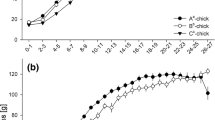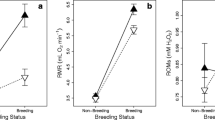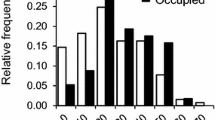Abstract
Maternal phenotype and maternal environment can profoundly affect the phenotype and fitness of offspring. Yet the causes of variation in such maternal effects are rarely known. Embryos in avian eggs cannot develop without being incubated and this creates an opportunity for maternal control of duration and onset of offspring development. However, females might adjust the start of incubation (e.g., coincident with the first egg or delayed until after egg-laying) in response to environmental conditions that they experience at the time of breeding. We studied two populations of the house finch (Carpodacus mexicanus) that breed at the climatic extremes of the species' geographical range (Montana and Alabama) and found that in both populations, the timing of incubation onset was closely associated with the bias in the sequence in which male and female eggs were laid within a clutch. When females started incubation with the first egg, they produced sons and daughters in highly biased sequence, when females delayed the onset of incubation until after the egg-laying, the sequence of sons and daughters was not biased. Because in both populations, onset of incubation was associated with the ambient temperature, these results emphasize that maternal effects on offspring can be influenced by ecological conditions experienced by parental generation.


Similar content being viewed by others
References
Albrecht DJ (2000) Sex ratio manipulation within broods of house wrens, Troglodytes aedon. Anim Behav 59:1227–1234
Anderson DJ, Reeve J, Bird DM (1997) Sexually dimorphic eggs, nestling growth and sibling competition in American Kestrels Falco sparverius. Funct Ecol 11:331–335
Badyaev AV (2002) Male and female growth in sexually dimorphic species: Harmony, conflict, or both? Comments Theor Biol 7:10–33
Badyaev AV, Hill GE (2000) The evolution of sexual dimorphism in the house finch. I. Population divergence in morphological covariance structure. Evolution 54:1784–1794
Badyaev AV, Hill GE, Whittingham LA (2001) The evolution of sexual size dimorphism in the house finch: IV. Population divergence in ontogeny of dimorphism. Evolution 55:2534–2549
Badyaev AV, et al. (2002) Sex-biased hatching order and adaptive population divergence in a passerine bird. Science 295:316–318
Badyaev AV, Beck ML, Hill GE, Whittingham LA (2003) The evolution of sexual size dimorphism in the house finch: V. Maternal effects. Evolution 57 (in press)
Bernardo J (1996) Maternal effects in animal ecology. Am Zool 36:83–105
Blanco G, Dávila JA, López Septiem JA, Rodríguez R, Martínez F (2002) Sex-biased initial eggs favour sons in the slightly size-dimorphic Scops owl (Otus scops). Biol J Linn Soc 76:1–7
Bortolotti GR (1986) Influence of sibling competition on nestling sex ratios of sexually dimorphic birds. Am Nat 127:495–507
Cordero PJ, Vinuela J, Aparicio JM, Veiga JP (2001) Seasonal variation in sex ratio and sexual egg dimorphism favouring daughters in first clutches of the spotless starling. J Evol Biol 14:829–834
Crisostomo S, Guemene D, Garreau-Mills M, Morvan C, Zadworny D (1998) Prevention of incubation behavior expression in turkey hens by active immunization against prolactin. Theriogenology 50:675–690
Daan S, Dijkstra C, Weissing FJ (1996) An evolutionary explanation for seasonal trends in avian sex ratio. Behav Ecol 7:426–430
Eising CM, Eikenaar C, Schwabl H, Groothuis GG (2001) Maternal antrogens in black-headed gull (Larus ridibunus) eggs: consequences for chick development. Proc R Soc Biol Sci Ser B 268:839–846
Fairbanks LA (1996) Individual differences in maternal style: Causes and consequences for mothers and offspring. Adv Stud Behav 25:579–611
Fear KK, Price T (1998) The adaptive surface in ecology. Oikos 82:440–448
Griffiths R, Daan S, Dijkstra.C. (1996) Sex identification in birds using two CHD genes. Proc R Soc Biol Sci Ser B 263:1251–1256
Griffiths R, Double M, Orr K, Dawson R (1998) A DNA test to sex most birds. Mol Ecol 7:1071–1076
Hanssen SA, Engebretsen H, Erikstad KE (2002) Incubation start and egg size in relation to body reserves in the common eider. Behav Ecol Sociobiol 52:282–288
Hébert PN (2002) Ecological factors affecting initiation of incubation behaviour. In: Deeming DC (ed) Avian incubation: behaviour, environment, and evolution. Oxford University Press, New York, pp 271-279
Henry MH, Burke WH (1999) The effects of in ovo administration of testosterone or an antiandrogen on growth of chick embryos and embryonic muscle characteristics. Poult Sci 78:1006–1013
Kirkpatrick M, Lande R (1989) The evolution of maternal effects. Evolution 43:485–503
Komdeur J, Pen I (2002) Adaptive sex allocation in birds: the complexities of linking theory and practice. Philos Trans R Soc Lond B Biol Sci 357:373–380
Komdeur J, Daan S, Tinbergen J, Mateman C (1997) Extreme adaptive modification in sex ratio of the Seychelles warbler's eggs. Nature 385:522–525
Komdeur J, Magrath MJL, Krackow S (2002) Pre-ovulation control of hatchling sex ratio in the Seychelles warbler. Proc R Soc Lond Ser B 269:1067–1072
Krackow S (1995) Potential mechanisms for sex ratio adjustment in mammals and birds. Biol Rev 70:225–241
Krackow S, Tkadlec E (2001) Analysis of brood sex ratios: implications of offspring clustering. Behav Ecol Sociobiol 50:293–301
Krebs EA, Green DJ, Double MC, Griffiths R (2002) Laying date and laying sequence influence the sex ratio of crimson rosella broods. Behav Ecol Sociobiol 51:447–454
Legge S, Hensohn R, Double M, Griffiths R, Cockburn A (2001) Complex sex allocation in the laughing kookaburra. Behav Ecol 12:524–533
Martin TE (2002) A new view of avian life-history evolution tested on an incubation paradox. Proc R Soc Lond Ser B 269:309–316
Mousseau TA, Fox CW (1998) The adaptive significance of maternal effects. Trends Ecol Evol 13:403–407
Price T (1998) Maternal and paternal effects in birds: Effects on offspring fitness. In: Mousseau TA, Fox CW (eds) Maternal effects as adaptations. Oxford University Press, New York, pp 202–226
Reece SE, Broderick AC, Godley BJ, West SA (2002) The effects of incubation environment, sex and pedigree on the hatching phenotype in a natural population of loggerhead turtles. Evol Ecol Res 4:737–748
Reed WL, Vleck CM (2001) Functional significance of variation in egg-yolk androgens in the American coot. Oecologia 128:164–171
Royle N, Surai PF, Hartley IR (2001) Maternally derived androgens and antioxidants in bird eggs: complementary but opposite effects? Behav Ecol 12:380–385
Schwabl H (1996a) Environment modifies the testosterone levels of a female bird and its eggs. J Exper Zool 276:157–163
Schwabl H (1996b) Maternal testosterone in the avian egg enhances postnatal growth. Comp Biochem Physiol 114:271–276
Schwabl H (1999) Maternal hormonal effects on postnatal development. In: Adams NJ, Slotow RH (eds) Proc Int Ornithol Congr 22:2807–2816
Sheldon BC, Merila J, Lindgren G, Ellegren H (1998) Gender and environmental sensitivity in nestling collared flycatchers. Ecology 79:1939–1948
Slagsvold T, Lifjeld JT (1989) Hatching asynchrony in birds: the hypothesis of sexual conflict over parental investment. Am Nat 134:239–253
Sockman KW, Schwabl H (2002) Covariation of clutch size, laying date and incubation tendency in the American Kestrel. Condor 103:570–578
Sockman KW, Schwabl H, Sharp PJ (2000) The role of prolactin in the regulation of clutch size and onset of incubation behavior in the American Kestrel. Horm Behav 38:168–178
Stoleson SH, Beissinger SR (1995) Hatching asynchrony and the onset of incubation in birds, revisited: when is the crucial period? Curr Ornithol 12:191–270
Trivers RL, Willard DE (1973) Natural selection of parental ability to vary the sex ratio of offspring. Science 179:90–91
Vleck CM (2002) Hormonal control of incubation behaviour. In: Deeming DC (ed) Avian incubation: behaviour, environment, and evolution. Oxford University Press, New York, pp 54–62
West SA, Sheldon BC (2002) Constraints in the evolution of sex ratio adjustment. Science 295:1685–1688
Wolf JB, Wade M (2001) On the assignment of fitness to parents and offspring: whose fitness is it and when does it matter? J Evol Biol 14:347–356
Acknowledgments
We thank B. Sheldon, B. Lyon, R. Duckworth, F. James, L. Oring, M. Mangel, E. Snell-Rood, M. Smith, B. Young, and an anonymous reviewer for discussion and the comments on the manuscript, personnel of the Vigilante MiniStorage in Missoula for allowing us to work on their property, L.A. Whittingham and H. Mays for sexing nestlings, and the NSF (DEB-0075388, DEB-0077804, IBN-9722171) for funding this work.
Author information
Authors and Affiliations
Corresponding author
Rights and permissions
About this article
Cite this article
Badyaev, A.V., Hill, G.E. & Beck, M.L. Interaction between maternal effects: onset of incubation and offspring sex in two populations of a passerine bird. Oecologia 135, 386–390 (2003). https://doi.org/10.1007/s00442-003-1203-x
Received:
Accepted:
Published:
Issue Date:
DOI: https://doi.org/10.1007/s00442-003-1203-x




